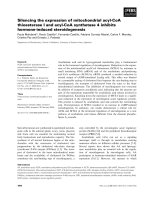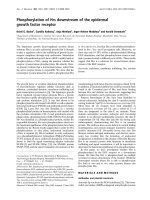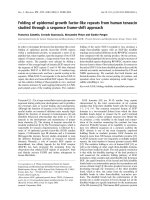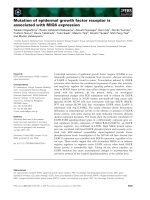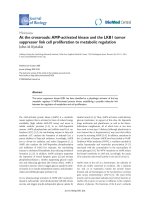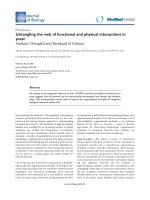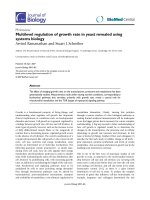Báo cáo sinh học: "Silencing the epidermal growth factor receptor gene with RNAi may be developed as a potential therapy for non small cell lung cancer" pot
Bạn đang xem bản rút gọn của tài liệu. Xem và tải ngay bản đầy đủ của tài liệu tại đây (528.08 KB, 12 trang )
BioMed Central
Page 1 of 12
(page number not for citation purposes)
Genetic Vaccines and Therapy
Open Access
Research
Silencing the epidermal growth factor receptor gene with RNAi
may be developed as a potential therapy for non small cell lung
cancer
Min Zhang
1
, Xin Zhang
1,2
, Chun-Xue Bai
1
, Xian-Rang Song
2
, Jie Chen
1
,
Lei Gao
1
, Jie Hu
1
, Qun-Ying Hong
1
, Malcolm J West
2
and Ming Q Wei*
2
Address:
1
Department of Pulmonary Diseases, Zhong Shan Hospital, Fudan University, Shanghai, PR China and
2
Department of Medicine,
University of Queensland, Prince Charles Hospital, Brisbane, Australia
Email: Min Zhang - ; Xin Zhang - ; Chun-Xue Bai - ; Xian-
Rang Song - ; Jie Chen - ; Lei Gao - ; ; Qun-
Ying Hong - ; Malcolm J West - ; Ming Q Wei* -
* Corresponding author
RNA interferenceepidermal growth factor receptordouble stranded RNAsmall interference RNAnon small cell lung cancer
Abstract
Lung cancer has emerged as a leading cause of cancer death in the world. Non-small cell lung cancer (NSCLC)
accounts for 75–80% of all lung cancers. Current therapies are ineffective, thus new approaches are needed to
improve the therapeutic ratio. Double stranded RNA (dsRNA) -mediated RNA interference (RNAi) has shown
promise in gene silencing, the potential of which in developing new methods for the therapy of NSCLC needs to
be tested. We report here RNAi induced effective silencing of the epidermal growth factor receptor (EGFR) gene,
which is over expressed in NSCLC. NSCLC cell lines A549 and SPC-A1 were transfected with sequence- specific
dsRNA as well as various controls. Immune fluorescent labeling and flow cytometry were used to monitor the
reduction in the production of EGFR protein. Quantitative reverse-transcriptase PCR was used to detect the level
of EGFR mRNA. Cell count, colony assay, scratch assay, MTT assay in vitro and tumor growth assay in athymic
nude mice in vivo were used to assess the functional effects of EGFR silencing on tumor cell growth and
proliferation. Our data showed transfection of NSCLC cells with dsRNA resulted in sequence specific silencing
of EGFR with 71.31% and 71.78 % decreases in EGFR protein production and 37.04% and 54.92% in mRNA
transcription in A549 and SPC-A1 cells respectively. The decrease in EGFR protein production caused significant
growth inhibition, i.e.: reducing the total cell numbers by 85.0% and 78.3 %, and colony forming numbers by 63.3%
and 66.8%. These effects greatly retarded the migration of NSCLC cells by more than 80% both at 24 h and at 48
h, and enhanced chemo-sensitivity to cisplatin by four-fold in A549 cells and seven-fold in SPC-A1. Furthermore,
dsRNA specific for EGFR inhibited tumor growth in vivo both in size by 75.06 % and in weight by 73.08 %. Our
data demonstrate a new therapeutic effect of sequence specific suppression of EGFR gene expression by RNAi,
enabling inhibition of tumor proliferation and growth. However, in vivo use of dsRNA for gene transfer to tumor
cells would be limited because dsRNA would be quickly degraded once delivered in vivo. We thus tested a new
bovine lentiviral vector and showed lentivector-mediated RNAi effects were efficient and specific. Combining
RNAi with this gene delivery system may enable us to develop RNAi for silencing EGFR into an effective therapy
for NSCLC.
Published: 30 June 2005
Genetic Vaccines and Therapy 2005, 3:5 doi:10.1186/1479-0556-3-5
Received: 04 April 2005
Accepted: 30 June 2005
This article is available from: />© 2005 Zhang et al; licensee BioMed Central Ltd.
This is an Open Access article distributed under the terms of the Creative Commons Attribution License ( />),
which permits unrestricted use, distribution, and reproduction in any medium, provided the original work is properly cited.
Genetic Vaccines and Therapy 2005, 3:5 />Page 2 of 12
(page number not for citation purposes)
Background
Lung cancer is a leading cause of cancer death in Australia
and the world [1,2]. There are two types of lung cancers,
non small cell (NSCLC) and small cell (SCLC). NSCLC
accounts for 75–80% of all lung cancers. Overall, NSCLC
has a low five-year survival rate of only 8–14%. Further-
more, approximately 75% of all NSCLC patients present
with advanced cancers [3]. The goals to manage this group
of patients are no longer curative, but instead, palliative,
to prolong the survival time through palliation chemo-
therapy or best supportive care [4]. The median survival of
a patient with advanced or metastasis NSCLC is approxi-
mately six to eight months [4,5]. Clearly, the future of
therapy depends on the development of new 'target
agents' that explore methods of inhibiting tumor growth,
or sensitizing tumors to chemotherapy or radiation to add
to current unsatisfactory therapeutic armament.
Gene therapy is one such strategy being considered. Sev-
eral genes have been explored, including tumour necrosis
factor [6], P53 tumour suppresser gene [7], Herpes Sim-
plex Virus Type-1 (HSV-1) thymidine kinase (TK), and
bacterial cytosine deaminase (CD) gene [8]. These
approaches generally tried to deliver the gene(s) to cancer
cells, and hoped that the transgene would be translated
into a protein to provide a therapeutic effect. However,
clinical trials have shown that the therapeutic outcome
was severely limited by the poor efficiency of current gene
transfer vector systems, inadequate weak promoters to
drive transgene expression. Therefore, so far, only three
cancer gene therapy protocols had reached phase III trials
before being terminated.
Epidermal growth factor receptor (EGFR) is a glycoprotein
with a molecular weight of 170,000 to 180,000. It is an
intrinsic tyrosine-specific protein kinase, which is stimu-
lated upon epidermal growth factor (EGF) binding. The
known downstream effectors of EGFR include PI3-K, RAS-
RAF-MAPK P44/P42, and protein kinase C signaling path-
ways. EGFR signaling involved in cell growth, angiogen-
esis, DNA repair, and autocrine growth regulation in
NSCLC as well as in a wide spectrum of human cancer
cells [9]. Thus, it has recently emerged as an innovative
target for the development of new cancer therapy, partic-
ularly for NSCLC [10].
Recently, a monoclonal antibody against EGFR called
cetuximab has been developed. It has shown excellent
clinical effects for the treatment of lung and head and
neck cancer in a clinical trial in humans [11,12]. Other
small chemical inhibitors, such as ZD-1839 have also
been developed and demonstrated anti-tumor effects in in
vitro and in vivo [13]. However, clinical use of ZD-1839 in
humans has not been very successful. Although long term
evaluation of the drug is still needed, ZD-1839, as a mon-
oclonal antibody drug (in a protein form), and as with
any other drug therapies, was disappointing, demonstrat-
ing the need for the development of new and effective
technologies [14].
Other novel products based on short DNA and RNA are
also currently being developed. These include LY900003
(Affinitac™), OST-774 (Tarceva™), and trastuzumab (Her-
ceptin). LY900003 is an antisense oligonucleotide, known
to modify gene expression by interacting with the mRNA
involved in the production of disease-specific proteins
[15]. However, antisense therapeutics have shortcomings
in specificity and consistency.
RNA interference (RNAi) is an evolutionarily conserved
process in which recognition of double-stranded RNA
(dsRNA) ultimately leads to posttranscriptional suppres-
sion of gene expression. This suppression is mediated by
short double stranded RNA (dsRNA), also called small
interfering RNA (siRNA), which induces specific degrada-
tion of mRNA through complementary base pairing. In
several model systems, ie.: mostly lower order animals,
this natural response has been developed into a powerful
tool for the investigation of gene function [16,17]. More
recently it was discovered that introducing synthetic 21-
nucleotide dsRNA duplexes into mammalian cells could
efficiently silence gene expression. Although the precise
mechanism is still unclear, RNAi offers a new way to inac-
tivate genes of interest. When compared with traditional
antisense knockout technologies, it provides a potential
new approach for modulation of oncogenic gene function
in cancer cells [18]. In this study, we investigated the pos-
sibility whether RNAi could silence EGFR gene in com-
monly used NSCLC cancer cell lines, A549 and SPC-A1.
We also assessed the degree of EGFR gene silencing and its
functional outcome in terms of effects on cell prolifera-
tion and growth inhibition in vitro and in vivo. Our
results suggest that RNAi-mediated silencing of EGFR may
provide an opportunity to develop a new treatment strat-
egy for NSCLC.
Materials and methods
Cell lines and cell culture
A549 and SPC-A1 are well-characterized human NSCLC
cell lines, obtained from the Chinese cell collection facil-
ity (Shenergy Biocolor Biological Science & Technology
Company, Shanghai, China). Cells were routinely grown
in Dulbecco's Modified Eagle's Medium (DMEM, Gibco,
USA) supplemented with 10% fetal bovine serum
(HyClone, USA) in a humidified atmosphere of 5% CO
2
at 37°C.
dsRNA preparation
siRNAs corresponding to EGFR mRNA with dTdT on 3'-
overhangs were designed and chemically synthesized
Genetic Vaccines and Therapy 2005, 3:5 />Page 3 of 12
(page number not for citation purposes)
according to the recommendation of the manufacturer
(Dharmacon Research, USA) [19]. The following
sequences were successfully made: siRNA-EGFR sense 5'-
GGAGCUGCCCAUGAGAAAUdTdT-3' and antisense 5'-
AUUUCUCAUG GGCAGCUCCdTdT-3'. The unrelated
nonspecific dsRNAs as control were designed as follow-
ing: sense 5'-GAACUUCAGGGUCAGCUUG CCdTdT-3'
and antisense 5'-GGCAAGCUGACCCUGAAGUUCdTdT-
3'. Single strand sense and antisense sequences were
annealed into dsRNA following the manufacturer's
instructions. The annealed dsRNAs were confirmed on a
15% PAGE gel electrophoresis.
In vitro transfection
Transfection of dsRNA was performed with commercial
reagent, Lipofectamine 2000 (Invitrogen, USA) in 6-well
plates following manufacturer's instructions. Briefly, the
day before transfection, confluent layers of cells were
trypsinized, counted and resuspended. Suspension of 1 ×
10
5
of cells was plated into each well of the 6-well plates,
so that they could become about 70% confluence next day
at the time of transfection. Lipofectamine 2000 was
diluted in serum-free DMEM and mixed with dsRNA at a
1:2 ratio (4 µl of 20 µmol/L of siRNA formulated with 8
µl of Lipofectamine 2000). The formulation of the mix-
ture continued at room temperature and was applied 25
min later in a final volume of 2 ml per well. The cells were
then incubated for another 48 h. Cell numbers were deter-
mined using a hemocytometer before subsequent assays.
Assessment of the EGFR numbers
The numbers of EGFR in both cell lines were determined
by an immuno-fluorescent assay as previously reported
[20]. The cells were harvested by trypsinization, washed
twice with 1 × PBS, and incubated with mouse anti-EGFR
monoclonal antibodies (mAb), (generously donated by
the Shanghai Institute of Cell Biology, Chinese Academy
of Sciences) for 1 h at 37 °C. The cells were then washed
and stained with FITC-conjugated rabbit anti-mouse anti-
body (Antibody Diagnostic Inc., Shanghai) and left for
incubation in the dark. After 45 min, the cells were sub-
squently washed twice and fixed in 0.5 ml of 4% para-for-
maldehyde. The stained cells were analyzed by a
fluorescent microscopy or on a Becton Dickinson FACS-
can with excitation and emission settings at 488 nm and
530 nm respectively. The numbers of EGFR on NSCLC
cells were finally calculated as the percentage of positive
cells × mean intensity of fluorescence.
RNA isolation and complementary DNA synthesis
Total RNA was extracted from cell pellets using Trizol rea-
gent following manufacturer's instructions (Gibco BRL,
Canada) and dissolved in TE buffer. Total RNA was quan-
tified with a spectrophotometer (Pharmacia Biotech, Pis-
cataway, NJ). To get rid of possible contamination by
genomic DNA, total RNA was treated with DNase I (Invit-
rogen, USA) for 15 min at room temperature. The reaction
was stopped by addition of 25 mM EDTA and heated at
65°C for 10 min followed by 95°C for 5 min. For comple-
mentary DNA (cDNA) synthesis, 400 ng of total RNA was
transcribed with cDNA transcription reagents using 0.8 µg
of the oligo(dT)
18
primer for subsequent quantitative,
real-time polymerase chain reaction (PCR).
Quantitative Reverse-Transcriptase PCR
This was performed using an ABI Prism 7700 sequence
detection system (Applied Biosystems) as described previ-
ously [21]. Primers and TaqMan probes were designed
using the Primer Express TM 1.0 (Applied Biosystems)
software to amplify approximately 150 base pairs of
sequences. Probes were labeled at 5' end with the reporter
dye molecule FAM (6-carboxy-fluorescein) and at 3' end
with quencher dye molecule TAMARA (6-carboxytetrame-
thyl-rhodamine). Real-time PCRs were conducted in a
total volume of 50 µl with 1 × TaqMan Master Mix
(Applied Biosystems) and primers at 300 nM and probes
at 200 nM. Primer sequences were as follows: EGFR gene
forward primer, 5' -CGAGGGCAAATACAGCTTTG -3';
backward primer, 5'- CCTTCGCACTTCTTACACTTG -3';
probe 5'FAM-ACGCCGTCTTCCTCCATCTCATA GC-
TAMRA3'. Thermal cycler parameters included one cycle
at 94°C for 2 min, and 45 cycles involving denaturation
at 94°C for 10 s annealing at 53°C for 30 s and extension
at 72°C for 40 s, followed by a final extension at 72°C for
10 min. The relative amount of EGFR cDNA in each sam-
ple was calculated by dividing the C
T
value with the corre-
sponding value of the housekeeping gene glyceraldehyde-
3-phosphate dehydrogenase (GAPDH). Negative controls
were included in each experiment to ensure the reagents
were free of contamination.
Colony forming assay
The number of colonies was determined as described pre-
viously [21]. Briefly, after transfection with dsRNA and
various controls, cells were trypsinized, counted, and
seeded for the colony forming assay in 60 mm dishes at
300 cells per dish. After incubation for 14 days, colonies
were stained with crystal violet and the numbers of posi-
tive cells counted. Colonies containing more than 50 cells
were scored, and triplicates containing 10–150 colonies/
dish were counted in each treatment.
Scratch assay
This was performed as previously described [22]. Cells
were seeded in triplicate on collagen IV coated 60 mm tis-
sue culture dishes at 1 × 10
5
cells/dish. A scratch through
the central axis of the plate was gently made using a
pipette tip 4 h after the cells were transfected with specific
dsRNA or various controls. Migration of the cells into the
Genetic Vaccines and Therapy 2005, 3:5 />Page 4 of 12
(page number not for citation purposes)
scratch was observed at two separate time points of 24 h
and 48 h.
Chemo-sensitivity assay
This was performed as described previously [23]. Briefly,
after transfection with specific dsRNA or various controls
in 6-well plates for 24 h, cells were trypsinized, and seeded
into 96 well plates. Cells were, after overnight culture,
exposed to increasing concentration of cisplatin ranged
from 0 to 50 ng/ml for another 24 h. MTT of 20 µl (1 mg/
ml) was added to each well for 4 h at 37°C to allow MTT
to form formazan crystals by reacting with metabolically
active cells. Subsequently the formazan crystals were solu-
bilized by 150 µl of DMSO. The absorbance of each well
was measured in a microplate reader at 490 nm (A
490
).
The percentage of cell growth was calculated by compari-
son of the A
490
reading from specific dsRNA transfected
cells versus control transfected cells.
Inhibition of tumor growth in athymic nude mice
Athymic nude mice (3–4 week old male) were obtained
from Shanghai Institute of Cell Biology, Chinese Academy
of Sciences, maintained under aseptic conditions and
cared in accordance with institutional guidelines. They
were then randomized into five groups with 6 mice per
group: ie.: negative control, positive control, transfection
reagent control, unrelated dsRNA control, and dsRNA spe-
cific for EGFR group (dsRNA-EGFR). After plating into 10
cm plate and transfection in vitro, SPC-A1 cells (~1 × 10
6
)
in 50 µl of PBS were injected s.c. into the left flank area of
the mice. An equal volume of PBS was injected into nega-
tive control group. Tumor volumes were determined by
direct measurement with calipers and calculated using the
formulaπ/6 × (larger diameter) × (small diameter).
Human tumor xenografts were allowed to grow to a size
of 10 mm × 10 mm before the mice were sacrificed and
tumors removed and weighed.
Statistical analysis
The silencing effects of dsRNA on EGFR on cell growth,
colony formation, cell migration and tumor growth in vivo
were analyzed by student t test. Differences were consid-
ered to be significant at P < 0.05. SPSS10.0 software was
used to perform statistical analysis. In the experiments for
testing chemo-sensitivity that involved multiple cisplatin
doses, the linear quadratic model was fitted with Origin
6.0 software.
ResultsSignificant down-regulation of EGFR gene
expression with siRNA specific for EGFR
Single stranded synthetic RNAs were firstly annealed
together to form dsRNA and then transiently transfected
into tumour cell lines. Forty-eight hours after transfection,
the expression of the EGFR was examined. The fluorescent
immune labeling assay demonstrated that the number of
the EGFR on the cell membrane was significantly and spe-
cifically inhibited by the transfection of dsRNA specific for
EGFR, but not by unrelated dsRNA (Fig. 1A c–d), nor by
the transfection reagent control and negative control
(without an mAb, Fig. 1A a–b). The number of the EGFR
assessed by a flow cytometry was also in agreement with
the immune assay in which dsRNA-EGFR dramatically
reduced EGFR gene expression to levels that were 71.31%
and 71.78% less than those seen in control groups (P <
0.001). There were no differences in the intensity of fluo-
rescence in the control groups, i.e.: both of the transfec-
tion reagent control as well as unrelated dsRNA group, did
not show any significant decrease (P > 0.05) (Fig. 1B
&1C), suggesting the reduction of the EGFR protein was
significant and specific.
Further molecular analyses revealed that the down-regula-
tion of EGFR expression was the result of a marked
decrease in the transcriptional activity of EGFR. As shown
in Fig. 1E, EGFR specific mRNA were strongly down-regu-
lated by 37.04% and 54.92% in A549 and SPA-A1 cells
treated with dsRNA-EGFR (P < 0.01). As anticipated,
mRNA transcription was not significantly inhibited in
groups (P > 0.05).
DsRNA specific for EGFR also inhibited tumor cell growth
To investigate the functional effect of the down regulation
of the EGFR expression, we performed two experiments;
one was a cell count assay and another, a colony forming
assay. Cell count results showed a significant decrease in
the number of cells by 85.0% in A549 and 78.3% in SPC-
A1 (P < 0.001) (Fig 2A) when transfected with dsRNA-
EGFR. In comparison, the number of cells in the control
groups was high and consistent in both cell types.
The results of the colony forming assay were in agreement
with those of cell count. A significant decrease in the
number of colonies by 63.3% in A549 and 66.8% in SPC-
A1 was apparent when the cells were transfected with
dsRNA-EGFR. In contrast, cells in the control groups
showed little decrease in the number of colonies. These
results suggest the transfection of NSCLC cells with
dsRNA-EGFR caused dramatic growth inhibition of the
tumor cells (P < 0.001) (Fig 2B).
DsRNA specific for EGFR retarded the migration of NSCLC
To determine whether gene silencing affected the ability
of A549 and SPC-A1 cells to migrate, a scratch assay was
performed by introduction of a scratch on the monolayer
of cells grown on collagen IV coated plates. The results
were quantitatively assessed at 24 h and 48 h and showed
that NSCLC cells transfected with dsRNA-EGFR had a very
low motility at both time points, representing a retarded
migration by more than 80% (Fig 3) (P < 0.01). The
Genetic Vaccines and Therapy 2005, 3:5 />Page 5 of 12
(page number not for citation purposes)
SiRNA-mediated RNAi effects in A549 and SPC-A1 cellsFigure 1
SiRNA-mediated RNAi effects in A549 and SPC-A1 cells. (A) dsRNA-mediated inhibition of EGFR gene expression in A549
cells (upper) and SPC-A1 cells (lower). Fluorescence images taken 48 h after transfection were shown. (a) Cells were stained
with FITC-conjugated secondary antibody. (b) Cells were stained with an EGFR-specific antibody and secondary antibody. (c)
FITC staining of cells transfected with unrelated dsRNA. (d) FITC staining of cells transfected with dsRNA-EGFR. (B) EGFR
gene expression was quantified in both control and transfected cells by a flow cytometry with excitation and emission settings
of 488 nm and 530 nm respectively. Cells were transfected for 48 h, then stained with an EGFR-specific antibody. Results were
expressed as the percentage of fluorescent intensity relative to controls. Each column represented the mean of three repli-
cated experiments. (C) EGFR gene level was quantified by real-time PCR. Expression of EGFR mRNA was analyzed using a
semiquantitative real-time PCR assay. The relative gene levels were calculated in relation to the expression of the housekeep-
ing GAPDH gene.
O L SR IH FW
D P LQ H
G V 51 $
X Q UH OD WH G
G V 51 $ (* )5
IOXRUHVFHQWLQWHQVLW\
$
6 3 & $
F
R
Q
WU
RO
O L S RI HF W DP LQ H
G V 5
1
$ X QU HO D W
H
G
G
V5
1
$
(
*)
5
(*)5*3'+
$
6 3 & $
A)
B)
C)
Genetic Vaccines and Therapy 2005, 3:5 />Page 6 of 12
(page number not for citation purposes)
The effects of dsRNA-EGFR on A549 (A) and SPC-A1 (B) cell count and colony formation (C)Figure 2
The effects of dsRNA-EGFR on A549 (A) and SPC-A1 (B) cell count and colony formation (C). Cells were seeded into 6 well
plates at a density of 1 × 10
5
per well. Forty-eight hours after transfection, cell numbers were determined using a hemocytom-
eter. For colony forming assay, cells transfected with siRNA,
F R Q W U R O O L S R I H F W
D P L Q H
G V 5 1 $
X Q U H O D W H G
G V 5 1 $ ( * ) 5
cell counts(×10000?
F R QW UR O O L SR IH FW DPL QH G V 51 $
X Q UH OD WH G
G V 51 $ (* )5
FHOOFRXQWVh
a
b
c d
A)
B)
C)
Genetic Vaccines and Therapy 2005, 3:5 />Page 7 of 12
(page number not for citation purposes)
Effects of siRNA-EGFR on NSCLC cells' ability to migrateFigure 3
Effects of siRNA-EGFR on NSCLC cells' ability to migrate. NSCLC cells in control group showed higher motility in a standard
scratch assay. The migration of A549 cells (upper) and SPC-A1 cells (lower) was quantitatively assessed at time points of 24 h
(white) and 48 h (black) after the introduction of a scratch in monolayer transfected cells grown on collagen IV. Each column
represented the mean of three experiments; bars, SD.
FRQWURO OLSRIHFWDPLQH GV51$XQUHODWHG GV51$(*)5
1XPEHURILQYDGLQJFHOOV
K
K
FRQWURO OLSRIHFWDPLQH GV51$
XQUHODWHG
GV51$(*)5
1XPEHURILQYDGLQJFHOOV
K
Genetic Vaccines and Therapy 2005, 3:5 />Page 8 of 12
(page number not for citation purposes)
results showed that dsRNA-EGFR transfected cells had
almost lost the ability to migrate, thus suggesting that
siRNA had the potential to reduce the invasiveness of
NSCLC, thus blocking migration and metastasis of
NSCLC tumours.
dsRNA sensitized NSCLC cell to chemo-therapeutic agent
cisplatin
To test what effect RNAi would have on the sensitivity of
NSCLC cells to a chemotherapeutic agent, we designed an
experiment to examine the changes of sensitivity to cispl-
atin before and after transfection with dsRNA. Cisplatin is
a commonly used chemical agent clinically. The experi-
ment was performed by examining cells' viability using a
MTT assay. As shown in Fig. 4, we demonstrated that cells
transfected with dsRNA-EGFR were more sensitive to cis-
platin than various control groups. More importantly, this
sensitizating effect was dose-dependent, showing a signif-
icant correlation of growth inhibition with doses of cispl-
atin used. When the data was further analyzed based on
the value of IC
50
using Origin 6.0 software, we demon-
strated that transfection of dsRNA-EGFR increased the
sensitivity of A549 and SPC-A1 to cisplatin by four- and
seven-fold respectively.
DsRNA specific for EGFR inhibited tumor growth in vivo
Clearly, it would be more relevant to the development of
a therapeutic protocol if we could prove that transfection
of siRNA could cause growth inhibition in vivo. In this
experiment, we investigated the possibility using a mouse
model of human tumor xenograft. Human SPC-A1 cells
were selected for the in vivo experiment because its subcu-
taneous xenografts formed quicker than A549 (Zhang et
al., unpublished data). Approximately 1 × 10
6
of SPC-A1
cells were transfected with dsRNA specific for EGFR or var-
ious controls, and then injected into the left flank area of
the mice. Tumor growth was monitored and xenografts
were allowed to grow to a size of approximately 10 mm ×
10 mm. After mice were sacrificed, tumors were removed
and weighed. As shown in Fig. 5, the time when tumors
were first visible in control groups was 6–8 days earlier
than that in dsRNA-EGFR transfected group. Tumors in
mock control group, transfection reagent control and
unrelated dsRNA transfected control groups were of a sim-
ilar size, all of which had a much larger solid tumor and
reddish appearance, whereas those from dsRNA-EGFR
transfected group remained small and pale. When mice
were sacrificed and the size of the tumors compared,
tumors from the dsRNA-EGFR transfected group showed
significant smaller size of 75.06 % and weight of 73.08%
(P < 0.01), demonstrating an in vivo growth inhibitory
effect.
Development of a uniqe lentiviral vector system encoding
dsRNA
No doubt, the in vivo use of dsRNA for gene transfer to
tumor cells would be limited because dsRNA would be
quickly degraded once delivered in vivo. In addition, the
efficiency of dsRNA-mediated gene transfer into tissues in
vivo would be very low and thus very limited. To improve
gene delivery to a variety of cancer cells in vivo, we devel-
oped a new bovine lentiviral vector (Jembrana Disease
Virus, JDV)-mediated delivery of RNAi approach. The JDV
vector system was recently developed in our laboratory
and has shown efficient gene delivery to a variety of cell
types both in dividing and non- dividing cycles [24,25].
Based on the JDV backbone, two 56 bp DNA fragments
that contain 19 bp of the EGFP in sense and anti-sense ori-
entation with a hairpin liker were synthesized, annealled
into double strands and cloned in a cassettes down stream
of a polymerase-III H1- RNA promoter (PIII). This pro-
moter directs transcription of the dsDNA into dsRNA with
well-defined start site with a termination signal consisting
of five thymidines in a row. Most importantly, the cleav-
age of the dsRNA transcript at the termination site is after
the second uridine, yielding a transcript resembling the
end of synthetic dsRNA.
The new JDV vector encoding the dsRNA specific for EGFR
is named pjLPIIIRE. Introduction of pjLPIIIRE together
with the packaging construct, pjPack and the envelop con-
struct, pCMV-VSVG into the 293T cells produced VSV-G
pseudotyped JDV vectors. The vector harvests were further
concentrated and titrated as we previously reported
[24,25]. These vectors were used to transducer A549 and
SPC-A1 cells. At a multiplicity of infection (MOI) of 10
and 72 hours after transduction, RNAi-mediated gene
silencing of EGFR was apparent. About 75% of A549 and
80% of SPC-A1 cells became EGFR negative, demonstrat-
ing an effective RNAi-mediated silencing of the EGFR
gene. Control constructs of JDV vectors encoding a dsRNA
specific for the enhanced green fluorescent protein
(EGFP) did not show a significant inhibitory effect at a
higher concentration of the vector (MOI of 15). However,
in cells that were previously transduced with EGFP marker
gene and expressing the EGFP protein in approximately
100% of the cells, about 75% of A549 and 80% of SPC-A1
cells became EGFR negative, a results similar to EGFR
silencing. These results suggested lentivector-mediated
RNAi effects were efficient and specific and would be a
useful tool for in vivo gene delivery for the therapy.
Discussion
Increased EGFR expression is common in various cancers.
This has correlated with neoplastic progression of these
cancers. Blockade of this oncogenic EGFR signaling path-
way may represent a promising strategy for the
Genetic Vaccines and Therapy 2005, 3:5 />Page 9 of 12
(page number not for citation purposes)
Effect of dsRNA-EGFR on chemosensitivity of NSCLC cells to cisplatinFigure 4
Effect of dsRNA-EGFR on chemosensitivity of NSCLC cells to cisplatin. Cells were transfected with siRNA, then exposed to
various doses of cisplatin for 48 h and viability was accessed. The percentage of cell growth was calculated by comparison of
the A
490
reading from treated versus control cells. The IC
50
value of A549 (upper) cells to cisplatin in control group, transfec-
tion reagent control, unrelated dsRNA group and dsRNA-EGFR group was 2.67 µg/ml, 2.30 µg/ml, 2.19 µg/ml and 0.50 µg/ml
respectively. The IC
50
value of SPC-A1 cells to cisplatin (lower) was 3.67 µg/ml, 3.11 µg/ml, 3.07 µg/ml and 0.43 µg/ml
respectively.
(
''3FRQFHQWUDWLRQVPJPO
VXUYLYDOSHUFHQWDJH
FRQWURO
/LSRIHFWDPLQH
GV51$XQUHODWHG
GV51$(*)5
''3FRQFHQWUDWLRQVPJPO
VXUYLYDOSHUFHQWDJH
FRQWURO
OLSRIHFWDPLQH
GV51$XQUHODWHG
GV51$(*)5
Genetic Vaccines and Therapy 2005, 3:5 />Page 10 of 12
(page number not for citation purposes)
Inhibition of tumor growth in vivo by dsRNA specific for EGFRFigure 5
Inhibition of tumor growth in vivo by dsRNA specific for EGFR. Transfected SPC-A1 cells (~1 × 10
6
) were injected into the left
flank area of the mice and tumor xenografts were allowed to grow to a size of approximately 10 mm × 10 mm. After mice
were sacrificed, tumors were removed and weighed. (A) Tumor volumes measured by calipers every 2 days. (B) Tumor weight.
Each column represented the mean of six mice, bars, SD.
(A)
FRQWURO OLSRIHFWDPLQH GV51$XQUHODWHG GV51$(*)5
WXPRUZHLJKW˄J˅
(B)
GD\
WXPRUYROXPH˄PP
F R QW UR O
O L SR IH FW DP L QH
G V 51 $ XQ UH O DW HG
G V 51 $ (* )5
Genetic Vaccines and Therapy 2005, 3:5 />Page 11 of 12
(page number not for citation purposes)
development of selective anticancer approaches. How-
ever, although considerable progress has been made in
the development of EGFR-targeted antibodies or small
molecule tyrosine kinase inhibitors, data from the current
clinical trials showed that there were some shortcomings
with these approaches, namely ineffective in some cases
and emergence of resistance in others [14]. In an effort to
develop new strategies to block the over expression of
EGFR in NSCLC cells, we examined the potential of a
dsRNA-mediated specific RNAi approach for silencing the
EGFR in NSCLC cell lines in vitro and in vivo. We demon-
strated a significant inhibition of EGFR gene expression in
both A549 and SPC-A1 cells. RNAi dramatically reduced
the EGFR transcription and down regulated protein pro-
duction. This, in turn, translated into a range of growth
inhibitory effects on the tumor cells in vitro and in vivo,
including a significant tumor growth delay and impair-
ment in xenograft animal models. Our results are the first
that show a significant silencing of an endogenous cellu-
lar gene and growth inhibition in vivo.
Current data supports the notion that in mammalian
cells, RNAi is superior to antisense approaches for down
regulation of gene expression though antisense had been
widely used [26]. Furthermore, dsRNA was more sensi-
tive, specific and stable than antisense RNA or DNA partly
due to its dTdT 3'-overhangs on each strand [27]. We
selected the 21-nt sense and antisense ssRNAs targeting
against EGFR from the coding regions and added dTdT 3'-
overhangs on each strand to increase siRNA stability. Our
current results were in agreement with reported data that
capped dsRNA was active and stable [28]. The RNAi effects
that we achieved more than doubled the effects of anti-
sense that was normally around 30% of down regulation
of gene expression (unpublished data).
It had been suggested that the degree to which the expres-
sion of a given protein to be inhibited through RNAi
depended on the half-life and its synthesis rate of that pro-
tein. Due to its much faster turnover, EGFR was consid-
ered to be more difficult to knock down using RNAi. This
was because even if the existing ready-made protein was
blocked, previously synthesized molecules persisted in
the plasma membrane for a relatively long time [29]. Nev-
ertheless the fact that we successfully inhibited the
expression of EGFR as well as the function of EGFR in
NSCLC cells provided convincing evidence that RNAi is a
very potent technique. To our knowledge, these results
represent the first demonstration that chemically syn-
thetic 21-nt siRNA was readily delivered into NSCLC cell
lines and effectively suppressed the oncogenic gene
expression and function.
Experimental and clinical data had indicated that EGFR
over expression correlated with various critical processes
in the development, maintenance, and spread of malig-
nant tumors.[30] The reduction of EGFR may lead to a
failure in downstream signal cascades including PI3-K,
RAS-RAF-MAPK P44/P42, and protein kinase C pathway,
and subsequently block the routes to activation of more
direct modulators of mitogenesis and other cancer-pro-
moting phenotypes [13]. Initially, due to the general
belief that RNAi only induces a gene knock down, rather
than a complete knock out, we were not quite sure what
functional outcome could be achieved by knocking down
EGFR, if any. Our results were most surprising and signif-
icant in that even though EGFR transcription was only
reduced by about 50% and protein production by 70%,
which means that the transfected cells would still express
more than 20% of receptors, these cells displayed,
however, dramatic growth inhibition in the number of
cell count, and colony formation and significantly
retarded cell growth. These results convincingly suggested
that even an incomplete suppression of EGFR expression
was sufficient to hinder growth factor-mediated signaling.
This was consistent with the hypothesis that the activation
of the tyrosine phosphorylation response might be com-
pletely switched off if the number of EGFR dropped below
a given threshold [31]. This notion is extremely important
for the development of a RNAi-mediated therapy of
NSCLC because a complete gene inactivation in these
cells, which is difficult to achieve is no longer needed sug-
gesting RNAi based gene silencing may be developed into
a therapy that could blunt the invasiveness of cancer cells,
even stop metastasis.
Up till now, the effects of EGFR on chemo-sensitivity were
less clear and were suggested that it might be depending
on particular tumor cell lines or cell types or particular
drugs used for the experiment. However, a growing
number of reports had supported the idea that activation
of the EGFR signal transduction pathway might induce
chemo-resistance in NSCLC cells [32]. This might provide
a rationale to down regulate EGFR, thus improving chem-
osensitivity. One of the commonly used drugs was cispla-
tin, a DNA-damaging anticancer agent. It has been
demonstrated that cisplatin modified DNA repair activity
in a variety of different experimental systems [33]. Our
study found that the reduction of EGFR resulted in
enhanced chemo-sensitivity to cisplatin by four-fold in
A549 cells and by seven-fold in SPC-A1 cells. In previous
studies using different receptor inhibitors, the degree of
EGFR-induced enhancement of sensitivity to cisplatin was
only in the range of 2- to 4- fold. Our seven-fold enhance-
ment in SPC-A1 cells suggested that RNAi caused better
suppression of the EGFR and increased significantly more
chemo-sensitivities than the previous approaches. This
would represent a clinical significance if translated into
clinical setting because cisplatin resistance could be
potentially overcome by this approach [34]. The chemo-
Publish with BioMed Central and every
scientist can read your work free of charge
"BioMed Central will be the most significant development for
disseminating the results of biomedical research in our lifetime."
Sir Paul Nurse, Cancer Research UK
Your research papers will be:
available free of charge to the entire biomedical community
peer reviewed and published immediately upon acceptance
cited in PubMed and archived on PubMed Central
yours — you keep the copyright
Submit your manuscript here:
/>BioMedcentral
Genetic Vaccines and Therapy 2005, 3:5 />Page 12 of 12
(page number not for citation purposes)
sensitization of NSCLC cells with dsRNA-EGFR indicated
that dsRNA-EGFR is a more fascinating candidate for fur-
ther development into a better therapy. Clearly, for the
development of such a therapeutic strategy for clinical
use, a suitable vector system is necessary. We have showed
the new lentiviral vector system was capable of delivery
dsRNA and caused a significant silencing effect. Our
development of the bovine lentiviral vector system for the
delivery of dsRNA would benefit the use of the technology
in vivo for NSCLC. Hopefully in the near future, strategies
based on RNAi will be ready for preclinical or clinical
trials.
Acknowledgements
We are grateful for the grant support from the Science and Technology
Commission, Shanghai Municipality (No 02DJ14027). We also thank
Queensland Cancer fund for grant (Q49-02) support to MW. Thanks also
go to colleagues in the gene therapy laboratory for discussion and prove
reading of the manuscript.
References
1. McLennan G., Roder DM: Lung cancer in Australia. Med J Aust
1989, 150:206-207.
2. Burton RC: Cancer control in Australia: into the 21 (st)
Century. Jpn J Clin Oncol 2002, 32:S3-9.
3. Hansen HH: Treatment of advanced non-small cell lung
cancer. BMJ 2002, 325:452-453.
4. Cridelli C: Targeted therapies in the treatment of non small
cell lung cancer:. Curr Opin Oncol 2004, 26:126-129.
5. Evans TL, Lynch TJ Jr: Lung Cancer. Oncologist 2001, 6:407-414.
6. Weichselbaum RR, Hallahan DE, Beckett MA, et al.: Gene therapy
targeted by radiation preferentially radiosensitizes tumor
cells. Cancer Res 1994, 54:4266-4269.
7. Gallardo D, Drazan KE, Mcbride WH: Adenovirus-based transfer
of wild-type p53 gene increases ovarian tumor
radiosensitivity. Cancer Res 1996, 56:4891-4893.
8. Rogulski KR, Kim JH, Kim SH, et al.: Glioma cells transduced with
an Escherichia coli CD/HSV-1 TK fusion gene exhibit
enhanced metabolic suicide and radiosensitivity. Hum Gene
Ther 1997, 8:73-85.
9. Wakeling AE: Epidermal growth factor receptor tyrosine
kinase inhibitors. Curr Opin Pharmacol 2002, 2:382-387.
10. Wakeling AE, Guy SP, Woodburn JR, et al.: ZD1839 (Iressa): an
orally active inhibitor of epidermal growth factor signaling
with potential for cancer therapy. Cancer Res 2002,
62:5749-5764.
11. Shin DM, Donato NJ, Perez-Soler R, et al.: Epidermal growth fac-
tor receptor-targeted therapy with C225 and cisplatin in
patients with head and neck cancer. Clin Cancer Res 2001,
7:1204-1213.
12. Ciardiello F, Caputo R, Blanco R, et al.: Inhibition of growth factor
production and angiogenesis in human cancer cells by ZD-
1839 (Iressa), a selective epidermal growth factor receptor
tyrosine kinase inhibitor. Clin Cancer Res 2000, 7:1459-1465.
13. Shawver LK, Slamon D, Ulrich A: Smart drugs: tyrosine kinase
inhibitors in cancer therapy. Cancer Cell 2002, 1:117-123.
14. Baselga J: The EGFR as a target for anticancer therapy – focus
on cetuximab. Eur J Cancer 2001, 37:S16-22.
15. Tamm I, Dorken B, Hartmann G: Antisense therapy in oncology,
new hope for an old idea? Lancet 2001, 358:489-497.
16. Elbashir SM, Lendechel W, Tuschl T: RNA interference is medi-
ated by 21- and 22-nucleotide RNAs. Genes Dev 2001,
15:188-200.
17. Hammond SM, Caudy AA, Hannon GJ: Post transcriptional gene
silencing by double stranded RNA. Nat Rev Genet 2001,
2:110-119.
18. Elbashir SM, Harborth J, Lendechel W, et al.: Duplexes of 21-nucle-
otides RNAs mediate RNA interference in cultured mam-
malian cells. Nature 2001, 411:494-498.
19. Christen RD, Hom DK, Porter DC, et al.: Epidermal growth fac-
tor regulates the in vitro sensitivity of human ovarian carci-
noma cells to cisplatin. J Clin Invest 1990, 86:1632-1640.
20. Kroning R, Jones JA, Hom DK, et al.: Enhancement of drug sensi-
tivity of human malignancies by epidermal growth factor. Br
J Cancer 1995, 72:615-619.
21. Zhang M, Zhang X, Bai CX, Chen J, Wei MQ: Inhibition of epider-
mal growth factor receptor (EGFR) by RNA interference in
A549 cells. Acta Pharmacol Sin 2004, 25:61-67.
22. Lal A, Glazer CA, Martinson HM, et al.: Mutant epidermal growth
factor receptor up-regulates molecular effectors of tumor
invasion. Cancer Res 2002, 62:3335-3340.
23. Liu CS, Kong BH, Xia HQ, et al.: VP22 enhanced intercellular
trafficking of HSV thymidine kinase reduced the level of gan-
ciclovir needed to cause suicide cell death. J Gene Med 2001,
3:145-152.
24. Metharom P, Tayra S, Xia HQ, MacMillian J, Shepherd R, Wilcox G,
Wei MQ: New bovine lentiviral vectors based on the Jem-
brana disease virus. J Gene Medicine 2002, 2:176-185.
25. Zhang B, Xia HQ, Cleghorn G, Gobe G, West M, Wei MQ: A highly
efficient and consistent method for harvesting large volumes
of high titre lentiviral vectors. Gene Therapy 2001, 8:1745-1751.
26. Nagy P, Arndt-Jovin DJ, Jovin TM: Small interfering RNAs sup-
press the expression of endogenous and GFP-fused epider-
mal growth factor receptor (erbB1) and induce apoptosis in
erbB1-overexpressing cells. Exp Cell Res 2003, 285:39-49.
27. Nieth C, Priebsch A, Stege A, et al.: Modulation of the classical
multidrug resistance (MDR) phenotype by RNA
interference(RNAi). FEBS Lett 2003, 545:144-150.
28. Tsai CM, Chang KT, Li L, Perng RP, Yang LY: Interrelationships
between cellular nucleotide excision repair, cisplatin cyto-
toxicity, HER-2/neu gene expression and epidermal growth
factor receptor level in non-small cell lung cancer. Jpn J Cancer
Res 2000, 91:213-22.
29. Somasundaram K: Stable RNA interference (RNAi) in mam-
malian cells. Cancer Biol Ther 2003, 2:211-212.
30. Magne N, Fischel JL, Dubreuil A, et al.: Sequence-dependent
effects of ZD1839 ('Iressa') in combination with cytotoxic
treatment in human head and neck cancer. Br J Cancer 2002,
86:819-827.
31. Hirata A, Ogawa S, Kometani T: ZD1839 (Iressa) induces antian-
giogenic effects through inhibition of epidermal growth fac-
tor receptor tyrosine kinase 2. Cancer Res 2002, 62:2554-2560.
32. Nakagawa K: Tyrosine kinase inhibitors-solid cancers. Gan To
Kagaku Ryoho 2001, 28:608-613.
33. Huang SM, Li J, Armstrong EA, et al.: Modulation of radiation
response and tumor induced angiogenesis after epidermal
growth factor receptor inhibition by ZD1839 (Iressa). Cancer
Res 2002, 62:4300-4306.
34. Williams KJ, Telfer BA, Stratford IJ, et al.: ZD1839 ('Iressa'), a spe-
cific oral epidermal growth factor receptor-tyrosine kinase
inhibitor, potentiates radiotherapy in a human colorectal
cancer xenegraft model. Br J Cancer 2002, 86:1157-1161.

